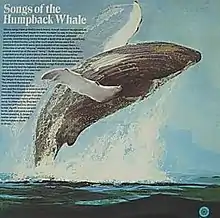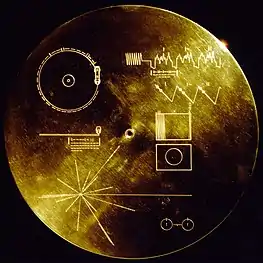Songs of the Humpback Whale (album)
Songs of the Humpback Whale is a 1970 album produced by bio-acoustician Roger Payne. It publicly demonstrated for the first time the elaborate whale vocalizations of Humpbacks, and became the bestselling environmental album in history, selling over 100,000 copies.[2] By raising awareness of the intelligence and culture of whales the album helped spawn a worldwide ”Save The Whales” movement, leading to the 1972 United Nations Conference on the Human Environment 10-year global moratorium on commercial whaling (observed by all but a few nations).[3]
| Songs of the Humpback Whale | ||||
|---|---|---|---|---|
 | ||||
| Studio album by | ||||
| Released | August 1970 | |||
| Recorded | 1970 | |||
| Genre | Environmental | |||
| Length | 34:26 | |||
| Label | CRM Records (1970), Capitol Records (1970), Windham Hill Records (1992), BGO Records (Compact Disc, remastered, 2001) | |||
| Producer | Roger Payne | |||
| Roger Payne chronology | ||||
| ||||
| Review scores | |
|---|---|
| Source | Rating |
| Allmusic | |
Background
Roger Payne had a background in bat and owl echolocation, but his interest in whale vocalizations came about circuitously. In the late 1960s he heard on the radio that a dead whale had washed up on Revere Beach (near Tufts University where he was working) so he drove out to see it. He found that souvenir hunters had already hacked off the flukes from the dead porpoise, somebody had carved their initials in its side, and a cigar butt had been stuffed into its blowhole.
“I removed the cigar and stood there for a long time with feelings I cannot describe. Everybody has some such experience that affects him for life, probably several. That night was mine.”[4] - Roger Payne
In 1966, Payne heard about the whale recordings of Frank Watlington, a Navy engineer who eight years earlier had captured eerie underwater moaning and wailing sounds while manning a top-secret hydrophone station off the coast of Bermuda, listening for Russian submarines.[5] Payne asked for and received copies of the recordings, and soon made the startling discovery that the songs repeated themselves, exactly. The shortest songs were in the six-minute range and the longest were over 30 minutes, and these could be repeated continuously for up to 24 hours. When the sounds were graphed they displayed a definite structure.[6]
Subsequent research by Payne and his then-wife Katharine Payne discovered that all whales in a given ocean (or at least, the males during breeding season) sing the same song.[6] Further, the whale songs change subtly from year-to-year, but never went back to previous songs.[7] Katy further discovered that the longer songs sung by the whales used the equivalent of “rhyming,” with key structures repeating at intervals. This raises the possibility that the whales use mnemonic devices to help them remember the more complicated songs.[8]
Reception
The album was an unexpected smash hit, quickly selling over 125,000 copies and eventually going multi-platinum, becoming the most popular nature recording in history.[6][9]
Excerpts from the record have shown up in songs by Judy Collins, Léo Ferré, Kate Bush and piece by Glass Wave in the symphonic suite And God Created Great Whales by Alan Hovhaness, and in the movie Star Trek IV: The Voyage Home. An excerpt was also included on the Voyager Gold Record which was carried aboard the Voyager program spacecraft.[9]
Circa 1975-1977, Payne followed up Songs of the Humpback Whale with a new record, Deep Voices - The Second Whale Record (Capitol ST 11598), which included sounds of blue whales and right whales.
The 1979 Vol. 155, No. 1 issue of National Geographic included a flexi disc with excerpts from Songs of the Humpback Whale. Distributed to 10.5 million subscribers, this constituted the largest single pressing in recording history, and helped to raise public awareness about whales.[10][9][11] (One source claims that whale recordings by Payne were distributed with a 1969 National Geographic issue.[12])
In 1989 excerpts from "Solo Whale" were used to create the sound effects for the rose form of the monster Biollante in the 1989 Toho film Godzilla vs. Biollante. Numerous other recordings of Humpback and other whales have attempted to capitalize on its popularity. In 2010 the album was inducted into the National Recording Registry as one of the significant recordings that "are culturally, historically, or aesthetically important, and/or inform or reflect life in the United States."
Track listing
- “Solo Whale” – 9:32 (recording: Frank Watlington)
- "Slowed-Down Solo Whale" – 1:05 (recording: Frank Watlington)
- “Tower Whales" – 3:23 (recording: Roger & Katharine Payne)
- “Distant Whale" – 3:55 (recording: Frank Watlington)
- “Three Whale Trip" – 16:31 (recording: Roger & Katharine Payne)
Production notes
- Produced by Roger Payne
- Recorded by Frank Watlington and Roger Payne
References
- Allmusic. "Roger Payne - Songs of the Humpback Whale". Allmusic. Retrieved 2 May 2018.
- O'Dell, Cary. ""Songs of the Humpback Whale" (1970)" (PDF). Library of Congress. Retrieved 5 May 2018.
- Liner notes to Songs of the Humpback Whale
- "Whale song: A grandfather's legacy". www.cbsnews.com.
- Rothenberg, David. "Nature's greatest hit: The old and new songs of the humpback whale - The Wire". The Wire Magazine - Adventures In Modern Music.
- Liner notes to Deep Voices
- Brody, Jane E. (November 9, 1993). "SCIENTIST AT WORK: Katy Payne; Picking Up Mammals' Deep Notes (Published 1993)" – via NYTimes.com.
- Lewis, Tim (December 6, 2020). "'It always hits me hard': how a haunting album helped save the whales" – via www.theguardian.com.
- "Haunting Whale Sounds Emerge From Ocean's Deepest Point". National Geographic News. March 5, 2016.
- "Issue 12-07 – Flexi – Electronic Sound". electronicsound.co.uk.
- Eshun, Kodwo (2007-06-06). "Songs of the Humpback Whale". frieze. No. 108. Archived from the original on 2019-06-08.
